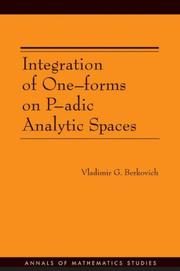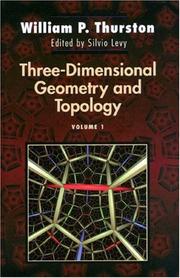| Listing 1 - 5 of 5 |
Sort by
|

ISBN: 0691000492 0691033323 1400882524 Year: 1993 Publisher: Princeton Princeton university press
Abstract | Keywords | Export | Availability | Bookmark
 Loading...
Loading...Choose an application
- Reference Manager
- EndNote
- RefWorks (Direct export to RefWorks)
Toric varieties are algebraic varieties arising from elementary geometric and combinatorial objects such as convex polytopes in Euclidean space with vertices on lattice points. Since many algebraic geometry notions such as singularities, birational maps, cycles, homology, intersection theory, and Riemann-Roch translate into simple facts about polytopes, toric varieties provide a marvelous source of examples in algebraic geometry. In the other direction, general facts from algebraic geometry have implications for such polytopes, such as to the problem of the number of lattice points they contain. In spite of the fact that toric varieties are very special in the spectrum of all algebraic varieties, they provide a remarkably useful testing ground for general theories. The aim of this mini-course is to develop the foundations of the study of toric varieties, with examples, and describe some of these relations and applications. The text concludes with Stanley's theorem characterizing the numbers of simplicies in each dimension in a convex simplicial polytope. Although some general theorems are "ed without proof, the concrete interpretations via simplicial geometry should make the text accessible to beginners in algebraic geometry.
Algebraic geometry --- Differential geometry. Global analysis --- 512.7 --- Algebraic geometry. Commutative rings and algebras --- Toric varieties. --- 512.7 Algebraic geometry. Commutative rings and algebras --- Toric varieties --- Embeddings, Torus --- Torus embeddings --- Varieties, Toric --- Algebraic varieties --- Addition. --- Affine plane. --- Affine space. --- Affine variety. --- Alexander Grothendieck. --- Alexander duality. --- Algebraic curve. --- Algebraic group. --- Atiyah–Singer index theorem. --- Automorphism. --- Betti number. --- Big O notation. --- Characteristic class. --- Chern class. --- Chow group. --- Codimension. --- Cohomology. --- Combinatorics. --- Commutative property. --- Complete intersection. --- Convex polytope. --- Convex set. --- Coprime integers. --- Cotangent space. --- Dedekind sum. --- Dimension (vector space). --- Dimension. --- Direct proof. --- Discrete valuation ring. --- Discrete valuation. --- Disjoint union. --- Divisor (algebraic geometry). --- Divisor. --- Dual basis. --- Dual space. --- Equation. --- Equivalence class. --- Equivariant K-theory. --- Euler characteristic. --- Exact sequence. --- Explicit formula. --- Facet (geometry). --- Fundamental group. --- Graded ring. --- Grassmannian. --- H-vector. --- Hirzebruch surface. --- Hodge theory. --- Homogeneous coordinates. --- Homomorphism. --- Hypersurface. --- Intersection theory. --- Invertible matrix. --- Invertible sheaf. --- Isoperimetric inequality. --- Lattice (group). --- Leray spectral sequence. --- Limit point. --- Line bundle. --- Line segment. --- Linear subspace. --- Local ring. --- Mathematical induction. --- Mixed volume. --- Moduli space. --- Moment map. --- Monotonic function. --- Natural number. --- Newton polygon. --- Open set. --- Picard group. --- Pick's theorem. --- Polytope. --- Projective space. --- Quadric. --- Quotient space (topology). --- Regular sequence. --- Relative interior. --- Resolution of singularities. --- Restriction (mathematics). --- Resultant. --- Riemann–Roch theorem. --- Serre duality. --- Sign (mathematics). --- Simplex. --- Simplicial complex. --- Simultaneous equations. --- Spectral sequence. --- Subgroup. --- Subset. --- Summation. --- Surjective function. --- Tangent bundle. --- Theorem. --- Topology. --- Toric variety. --- Unit disk. --- Vector space. --- Weil conjecture. --- Zariski topology.

ISBN: 0691128626 1299133339 1400837154 0691127417 9781400837151 9780691127415 9780691128627 9781299133334 Year: 2007 Volume: no. 162 Publisher: Princeton, N.J. Princeton University Press
Abstract | Keywords | Export | Availability | Bookmark
 Loading...
Loading...Choose an application
- Reference Manager
- EndNote
- RefWorks (Direct export to RefWorks)
Among the many differences between classical and p-adic objects, those related to differential equations occupy a special place. For example, a closed p-adic analytic one-form defined on a simply-connected domain does not necessarily have a primitive in the class of analytic functions. In the early 1980s, Robert Coleman discovered a way to construct primitives of analytic one-forms on certain smooth p-adic analytic curves in a bigger class of functions. Since then, there have been several attempts to generalize his ideas to smooth p-adic analytic spaces of higher dimension, but the spaces considered were invariably associated with algebraic varieties. This book aims to show that every smooth p-adic analytic space is provided with a sheaf of functions that includes all analytic ones and satisfies a uniqueness property. It also contains local primitives of all closed one-forms with coefficients in the sheaf that, in the case considered by Coleman, coincide with those he constructed. In consequence, one constructs a parallel transport of local solutions of a unipotent differential equation and an integral of a closed one-form along a path so that both depend nontrivially on the homotopy class of the path. Both the author's previous results on geometric properties of smooth p-adic analytic spaces and the theory of isocrystals are further developed in this book, which is aimed at graduate students and mathematicians working in the areas of non-Archimedean analytic geometry, number theory, and algebraic geometry.
p-adic analysis. --- Analysis, p-adic --- Algebra --- Calculus --- Geometry, Algebraic --- Abelian category. --- Acting in. --- Addition. --- Aisle. --- Algebraic closure. --- Algebraic curve. --- Algebraic structure. --- Algebraic variety. --- Allegory (category theory). --- Analytic function. --- Analytic geometry. --- Analytic space. --- Archimedean property. --- Arithmetic. --- Banach algebra. --- Bertolt Brecht. --- Buttress. --- Centrality. --- Clerestory. --- Commutative diagram. --- Commutative property. --- Complex analysis. --- Contradiction. --- Corollary. --- Cosmetics. --- De Rham cohomology. --- Determinant. --- Diameter. --- Differential form. --- Dimension (vector space). --- Divisor. --- Elaboration. --- Embellishment. --- Equanimity. --- Equivalence class (music). --- Existential quantification. --- Facet (geometry). --- Femininity. --- Finite morphism. --- Formal scheme. --- Fred Astaire. --- Functor. --- Gavel. --- Generic point. --- Geometry. --- Gothic architecture. --- Homomorphism. --- Hypothesis. --- Imagery. --- Injective function. --- Irreducible component. --- Iterated integral. --- Linear combination. --- Logarithm. --- Marni Nixon. --- Masculinity. --- Mathematical induction. --- Mathematics. --- Mestizo. --- Metaphor. --- Morphism. --- Natural number. --- Neighbourhood (mathematics). --- Neuroticism. --- Noetherian. --- Notation. --- One-form. --- Open set. --- P-adic Hodge theory. --- P-adic number. --- Parallel transport. --- Patrick Swayze. --- Phrenology. --- Politics. --- Polynomial. --- Prediction. --- Proportion (architecture). --- Pullback. --- Purely inseparable extension. --- Reims. --- Requirement. --- Residue field. --- Rhomboid. --- Roland Barthes. --- Satire. --- Self-sufficiency. --- Separable extension. --- Sheaf (mathematics). --- Shuffle algebra. --- Subgroup. --- Suggestion. --- Technology. --- Tensor product. --- Theorem. --- Transept. --- Triforium. --- Tubular neighborhood. --- Underpinning. --- Writing. --- Zariski topology.
Book
ISBN: 0691223629 Year: 2021 Publisher: Princeton, New Jersey ; Oxford : Princeton University Press,
Abstract | Keywords | Export | Availability | Bookmark
 Loading...
Loading...Choose an application
- Reference Manager
- EndNote
- RefWorks (Direct export to RefWorks)
"Despite substantial, cross-disciplinary interest in the subject as a scientific case study, surprisingly little has been written on the science of snowflakes and their formation. For materials scientists, snowflakes constitute archetypal examples of crystal growth; for chemists, the site of complex molecular dynamics at the ice surface. Physicists can learn from snowflake symmetry and self-assembly; geologists study snow as mineral crystals; and biologists can even gain insight into the creation of shape and order in organisms. In the humble snowflake are condensed many of the processes-many of them still not fully understood-that govern the organization of classical systems at all levels of the natural world. This book by Kenneth Libbrecht-inarguably the world's foremost expert on the subject-will be the authoritative text on the science of snow crystals. It will cover all of the physical processes that govern the life of a snowflake, including how snowflakes grow and why they have the shapes they do. It will also outline techniques for creating and experimenting with snow crystals, both with computer models and in the lab. Featuring hundreds of color illustrations, the book will be comprehensive and is sure to become definitive resource for researchers for years, if not decades, to come"--
Snowflakes. --- Flakes, Snow --- Snow crystals --- Snow flakes --- Snow --- Accuracy and precision. --- Artistic rendering. --- Atmospheric pressure. --- Atmospheric sciences. --- Attic calendar. --- Baking. --- Biomolecule. --- Blood Glucose. --- Branching (polymer chemistry). --- By-product. --- Camera. --- Camphor. --- Canon EOS 5D. --- Chemical bond. --- Chemical formula. --- Chisel. --- Circumference. --- Clear ice. --- Cloud. --- Coefficient. --- Collision. --- Computational chemistry. --- Computational model. --- Consumer. --- Crystal growth. --- Crystal structure. --- Crystal. --- Cubic crystal system. --- Curvature. --- Cytokine. --- Deforestation. --- Desiccation. --- Dew point. --- Diagram. --- Diffusion equation. --- Dimension. --- Dislocation. --- Drop (liquid). --- Economic development. --- Facet (geometry). --- Faceting. --- Field lens. --- Focus stacking. --- Freedman. --- Glucocorticoid. --- Glycoside. --- Hatchling. --- Heat exchanger. --- Hydrogen atom. --- Ice Ih. --- Ice. --- Implementation. --- Impurity. --- Isotropy. --- Latent heat. --- Lighting. --- Liquid crystal. --- Menopause. --- Micrograph. --- Mitutoyo. --- Molecule. --- Neglect. --- Nematode. --- Nomenclature. --- Nucleation. --- Parabola. --- Parasitoid. --- Pedagogy. --- Percentage. --- Petite bourgeoisie. --- Phase (matter). --- Pixel. --- Planned economy. --- Plate column. --- Properties of water. --- Public sector. --- Quadratic equation. --- Refractive index. --- Result. --- Scientific method. --- Snow. --- Southwestern United States. --- Sovereignty. --- Stabilization policy. --- Stagnation point. --- State management. --- Steradian. --- Stokes' law. --- Storage tank. --- Stunted growth. --- Supersaturation. --- Surface diffusion. --- Surface energy. --- Surface roughness. --- Temperature gradient. --- Temperature. --- Video production. --- Visual effects. --- Website. --- Zero of a function.
Book
ISBN: 1400881722 Year: 2016 Publisher: Princeton, NJ : Princeton University Press,
Abstract | Keywords | Export | Availability | Bookmark
 Loading...
Loading...Choose an application
- Reference Manager
- EndNote
- RefWorks (Direct export to RefWorks)
The description for this book, Contributions to the Theory of Games (AM-24), Volume I, will be forthcoming.
Game theory. --- Affine space. --- Almost surely. --- Banach space. --- Basic solution (linear programming). --- Bilinear form. --- Boundary (topology). --- Bounded variation. --- Calculation. --- Characteristic function (probability theory). --- Characterization (mathematics). --- Coefficient. --- Combination. --- Completeness of the real numbers. --- Computation. --- Computational problem. --- Connected space. --- Continuous function (set theory). --- Continuous function. --- Continuous game. --- Convex combination. --- Convex set. --- Counterexample. --- Diagram (category theory). --- Dimension (vector space). --- Dimension. --- Dimensional analysis. --- Elementary proof. --- Equation solving. --- Equilibrium point. --- Euclidean space. --- Existential quantification. --- Exterior (topology). --- Extreme point. --- Facet (geometry). --- Fubini's theorem. --- Function (mathematics). --- Function space. --- Fundamental theorem. --- Geometry. --- Helly's theorem. --- Hyperplane. --- Identity matrix. --- Inequality (mathematics). --- Infimum and supremum. --- Interior (topology). --- Invertible matrix. --- Iterative method. --- Limit of a sequence. --- Limit point. --- Linear inequality. --- Linear map. --- Linear programming. --- Mathematical analysis. --- Mathematical optimization. --- Mathematics. --- Matrix (mathematics). --- Maxima and minima. --- Maximal set. --- Measure (mathematics). --- Minimax theorem. --- Mutual exclusivity. --- NSPACE. --- Orthogonal basis. --- Orthogonal matrix. --- Orthogonal polynomials. --- Partially ordered set. --- Permutation. --- Polyhedron. --- Polynomial. --- Probability distribution. --- Probability. --- Proportionality (mathematics). --- Rational number. --- Riemann–Stieltjes integral. --- Scientific notation. --- Set (mathematics). --- Set theory. --- Sign (mathematics). --- Skew-symmetric matrix. --- Solution concept. --- Special case. --- Strategy (game theory). --- Subsequence. --- Subset. --- Summation. --- Symmetrization. --- Theorem. --- Theory of Games and Economic Behavior. --- Theory. --- Topology. --- Transfinite number. --- Transfinite. --- Unit interval. --- Unit sphere. --- Unit vector. --- Vandermonde matrix. --- Variable (mathematics). --- Vector space. --- Weak convergence (Hilbert space). --- Weyl's theorem.

ISBN: 0691083045 1400865328 9780691083049 Year: 1997 Volume: 35. Publisher: Princeton : Princeton University Press,
Abstract | Keywords | Export | Availability | Bookmark
 Loading...
Loading...Choose an application
- Reference Manager
- EndNote
- RefWorks (Direct export to RefWorks)
This book develops some of the extraordinary richness, beauty, and power of geometry in two and three dimensions, and the strong connection of geometry with topology. Hyperbolic geometry is the star. A strong effort has been made to convey not just denatured formal reasoning (definitions, theorems, and proofs), but a living feeling for the subject. There are many figures, examples, and exercises of varying difficulty. This book was the origin of a grand scheme developed by Thurston that is now coming to fruition. In the 1920s and 1930s the mathematics of two-dimensional spaces was formalized. It was Thurston's goal to do the same for three-dimensional spaces. To do this, he had to establish the strong connection of geometry to topology--the study of qualitative questions about geometrical structures. The author created a new set of concepts, and the expression "Thurston-type geometry" has become a commonplace. Three-Dimensional Geometry and Topology had its origins in the form of notes for a graduate course the author taught at Princeton University between 1978 and 1980. Thurston shared his notes, duplicating and sending them to whoever requested them. Eventually, the mailing list grew to more than one thousand names. The book is the culmination of two decades of research and has become the most important and influential text in the field. Its content also provided the methods needed to solve one of mathematics' oldest unsolved problems--the Poincaré Conjecture. In 2005 Thurston won the first AMS Book Prize, for Three-dimensional Geometry and Topology. The prize recognizes an outstanding research book that makes a seminal contribution to the research literature. Thurston received the Fields Medal, the mathematical equivalent of the Nobel Prize, in 1982 for the depth and originality of his contributions to mathematics. In 1979 he was awarded the Alan T. Waterman Award, which recognizes an outstanding young researcher in any field of science or engineering supported by the National Science Foundation.
Topology --- Differential geometry. Global analysis --- Geometry, Hyperbolic --- Three-manifolds (Topology) --- Géométrie hyperbolique --- Variétés topologiques à 3 dimensions --- Geometry, Hyperbolic. --- 514.1 --- 3-manifolds (Topology) --- Manifolds, Three dimensional (Topology) --- Three-dimensional manifolds (Topology) --- Low-dimensional topology --- Topological manifolds --- Hyperbolic geometry --- Lobachevski geometry --- Lobatschevski geometry --- Geometry, Non-Euclidean --- General geometry --- Three-manifolds (Topology). --- 514.1 General geometry --- Géométrie hyperbolique --- Variétés topologiques à 3 dimensions --- 3-sphere. --- Abelian group. --- Affine space. --- Affine transformation. --- Atlas (topology). --- Automorphism. --- Basis (linear algebra). --- Bounded set (topological vector space). --- Brouwer fixed-point theorem. --- Cartesian coordinate system. --- Characterization (mathematics). --- Compactification (mathematics). --- Conformal map. --- Contact geometry. --- Curvature. --- Cut locus (Riemannian manifold). --- Diagram (category theory). --- Diffeomorphism. --- Differentiable manifold. --- Dimension (vector space). --- Dimension. --- Disk (mathematics). --- Divisor (algebraic geometry). --- Dodecahedron. --- Eigenvalues and eigenvectors. --- Embedding. --- Euclidean space. --- Euler number. --- Exterior (topology). --- Facet (geometry). --- Fiber bundle. --- Foliation. --- Fundamental group. --- Gaussian curvature. --- Geometry. --- Group homomorphism. --- Half-space (geometry). --- Holonomy. --- Homeomorphism. --- Homotopy. --- Horocycle. --- Hyperbolic geometry. --- Hyperbolic manifold. --- Hyperbolic space. --- Hyperboloid model. --- Interior (topology). --- Intersection (set theory). --- Isometry group. --- Isometry. --- Jordan curve theorem. --- Lefschetz fixed-point theorem. --- Lie algebra. --- Lie group. --- Line (geometry). --- Linear map. --- Linearization. --- Manifold. --- Mathematical induction. --- Metric space. --- Moduli space. --- Möbius transformation. --- Norm (mathematics). --- Pair of pants (mathematics). --- Piecewise linear manifold. --- Piecewise linear. --- Poincaré disk model. --- Polyhedron. --- Projection (linear algebra). --- Projection (mathematics). --- Pseudogroup. --- Pullback (category theory). --- Quasi-isometry. --- Quotient space (topology). --- Riemann mapping theorem. --- Riemann surface. --- Riemannian manifold. --- Sheaf (mathematics). --- Sign (mathematics). --- Simplicial complex. --- Simply connected space. --- Special linear group. --- Stokes' theorem. --- Subgroup. --- Subset. --- Tangent space. --- Tangent vector. --- Tetrahedron. --- Theorem. --- Three-dimensional space (mathematics). --- Topological group. --- Topological manifold. --- Topological space. --- Topology. --- Transversal (geometry). --- Two-dimensional space. --- Uniformization theorem. --- Unit sphere. --- Variable (mathematics). --- Vector bundle. --- Vector field. --- Topologie algébrique --- Topologie combinatoire --- Algebraic topology. --- Combinatorial topology. --- Variétés topologiques --- Geometrie --- Theorie des noeuds
| Listing 1 - 5 of 5 |
Sort by
|

 Search
Search Feedback
Feedback About
About Help
Help News
News